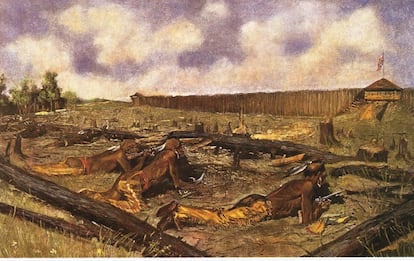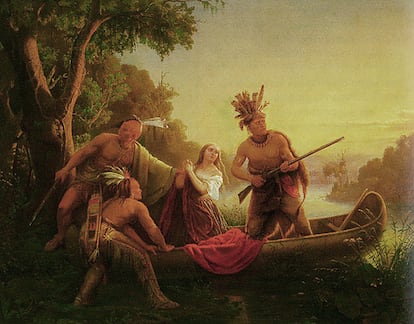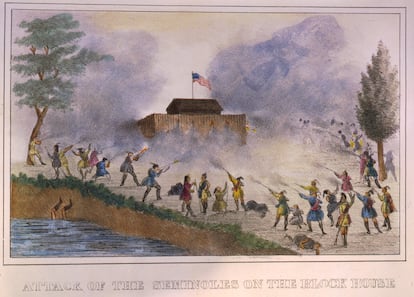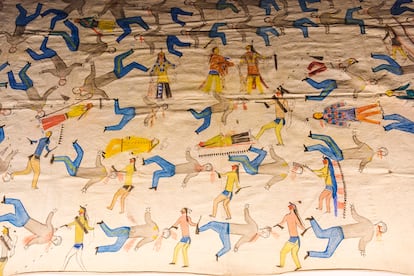NOTE: For those of you who read ALMOST DEAD INDIANS, you will know I have a chapter on FORT DETROIT which explains taking captives/captivity/adoption, collecting and taking scalps and the conditions for the tribes dealing with the French, British and Spanish invaders and the Long Knives (Virginians, pre-America).
There is also history about New England, like King Phillips War and the Phips Proclamation. You really need to understand this real history, our tribal histories.... and I made it easy to read...Trace
THIS IS SO HELPFUL!👇Finnish historian Pekka Hämäläinen – who hates the film ‘Dances with Wolves’ – wrote a book called ‘Indigenous Continent,’ in which he explains that the tribes of North America had notable military capacity and that their defeat was by no means inevitable...
The defeat of Custer and his Seventh Cavalry at the hands of the Sioux and Cheyennes at Little Bighorn in 1876 was not at all a matter of bad luck on the part of the general and his troops. Rather, it was the logical and expected result of the Indigenous people being better strategists, more familiar with the terrain and tactically superior to the American soldiers.
By no means was this the only time in which the so-called “redskins” — a derogatory term — proved to be very capable of defeating the whites and imposing their own military dynamics from the beginning of the 16th century until the end of the 19th century. In a fascinating history of the American Indian Wars — Indigenous Continent: The Epic Contest for North America (2022) — Finnish historian Pekka Hämäläinen calls into question the inevitability of colonial expansionism. The researcher — who holds a doctorate in History from the University of Helsinki and is considered to be one of the world’s specialists in the conquest of North America — reveals how, on several occasions, the Indigenous people came close to inflicting a definitive defeat on the European colonial powers, as well as the United States.
In fact, they nearly expelled these settlers from North America entirely.
In the revolutionary account by the 57-year-old Hämäläinen — who is currently the Rhodes Professor of American History at the University of Oxford — the Indigenous tribes of North America cease to be the usual passive victims, subject to an inexorable and irreversible destiny. Instead, in the book, they become powerful agents who dominated the continent for centuries after the arrival of the colonizers and represented a very serious threat to their plans of conquest.

The continent, Hämäläinen points out, was in the hands of the Indigenous peoples for much longer than we usually think. They had political entities with extraordinary warlike capacity, such as the Iroquois League — whose power, he reminds us, lasted from the 16th to the 19th century, “which makes this nation the oldest and gives it a more central historical role than the United States” — or the Comanche and Sioux equestrian empires, which he compares to other powerful tribes of horseback nomads, such as the Mongols.
On a date like 1776 — when the independence of the United States was proclaimed — the scholar tells EL PAÍS that “the Europeans claimed most of the continent… but the natives, as a whole, effectively controlled it.” The expert affirms that instead of talking about a “colonial America,” we should talk about an “Indigenous America” that became colonial “only slowly and unevenly.” In fact, it remained “overwhelmingly Indigenous until well into the 19th century.” Countless native nations, he claims, “fought fiercely to keep their territories intact and their cultures unscathed” and “came to thwart the imperialist pretensions of France, Spain, Great Britain, the Netherlands and, later, the United States.”
The scholar’s narrative follows the Indian Wars in a meticulously-documented and very engaging way, contrasting sharply with the somber and traditional structure of classics such as Bury My Heart at Wounded Knee (1970), by Dee Brown. This book established an idea in the popular consciousness — reinforced by the film Dances with Wolves (1990) — that the fight against the whites was an unavoidable march towards the disaster of Indigenous societies, which were doomed since the first settlers set foot in North America. However, Hämäläinen shows how, in fact, the colonizers often moved on the margins of powerful Indian tribes and confederations, retreating on many occasions, with their colonial project bordering on disaster. And the Indigenous people didn’t sit around nursing feelings of melancholy or disaster: rather, they were muscular, full of vitality and equipped with the resources and weapons needed to fight.
Throughout Indigenous Continent, Hämäläinen portrays the native people as “strong, creative and resilient” historical actors. In the work, he highlights that they were by no means one-dimensional tribes, as they have been shown in a traditional narrative “entrenched in our [Western] culture and our mentality.”

Along with the word “empires” — which draws so much attention in relation to Indigenous peoples of North America, who are popularly associated more with veritable gangs — the researcher chooses to refer to the native warriors as “soldiers” (which equates them militarily with white combatants) and uses Indigenous terms for the leaders and authorities of tribal nations, instead of the standard use of “chiefs.” It’s also notable that, in several cases, he uses the names that these nations prefer to use, instead of the more common ones given to them by the whites or their enemies. For instance, he uses Wyandot people instead of Hurons and Meswaki Nation instead of the Fox tribe.

In his account of the “overwhelming and persistent Indigenous power in North America” — after some chapters in which he explains the past of the societies that faced European colonization, highlighting their “horizontal and consensual” concept of leadership — Hämäläinen reviews the early conflicts with the Spanish, French and English, while touching on how the pilgrims from the Mayflower were allowed in because they were useful in the Wampanoags’ strategy against their Indigenous enemies. The historical Uncas and their manipulation of the Connecticut settlers to achieve primacy over the Pequots also appears in the book. As does the central role of women in the politics of the League of Five Nations — which so surprised the French (other Indigenous women, such as the Cherokees, could even go into battle) — and the “overwhelming military superiority of the Iroquois.” The Mohawk, Hämäläinen emphasizes, “had gone beyond containing the Europeans… they demanded obedience from them.”

New England was nearly destroyed in 1675. And all colonial projects on the continent seemed to falter or expire entirely between that date and 1690, during what Hämäläinen refers to as an Indigenous “backlash.” King Philip’s War (1675-1676) forced New York to be defended. The scholar emphasizes that the cruelty that the whites deployed was a sign of weakness: it’s no coincidence that the terror they felt was expressed in a psychosis of demons and witches. In 1692, Salem was only 50 miles away from the Indigenous border.
In the southwest, the rebellion of the Pueblo Indians broke out in 1680. Colonialism receded throughout North America at the end of the 17th century. In 1763 came the Pontiac War. And, in the 18th and 19th centuries, the threat came especially from the Comanche and Lakota equestrian empires, whose Seven Council Fires were the most powerful Indigenous force on the continent, after the weakening of the Iroquois and Cherokee peoples in the Seven Years’ War (1756-1763).
Hämäläinen also points out that the Sioux and their allies defeated the United States in two wars: first in Red Cloud (1866) and then in the campaign that ended at Little Bighorn. He writes how the Lakota Empire — also known as the Teton Sioux — served as an involuntary protective shield for a multitude of smaller Indigenous nations, keeping the US militias and soldiers at bay for decades.
The chronicle of the powerful Indigenous resistance is lengthy. It includes Osceola — the leader of the Seminoles of Florida — or Black Hawk, the Sauk leader west of Lake Michigan. The Kiowa and Apache people are also mentioned. Indeed, there were fires of resistance everywhere. The United States was only able to finally extinguish them after “four centuries of Indigenous power” by applying a genocidal policy.
The Wounded Knee Massacre of 1890, Hämäläinen states, was a sign of settler weakness and fear. The US was exhausted after more than 1,600 official armed clashes against the natives. “There’s a direct link between Indigenous success and the sense of vulnerability — and the magnitude of revenge — of the Americans.”

Could the history of North America be different from what has been taught?
“As historians, we can only point out the possible forks in the road… but in 1776, it was certainly possible to imagine a future on the continent in which [Indigenous] peoples controlled it.”
For Hämäläinen, the military technology of the European settlers wasn’t as superior as is believed. “It was important, without a doubt. But it must also be taken into account that there wasn’t a single moment in North American history in which that technology wasn’t also available to the [Indigenous people], or even transferred by them to others. Success in war often lies less in technology per se and more in social, cultural and strategic issues of access to technology and what’s done with it. We’re making a mistake if we conceive the continent’s military history as having been a battle between Europeans with modern military technology against Indigenous peoples without it. Much more important is the scale at which communities can access and effectively deploy such technology.”

Among the most exciting pages of Indigenous Continent is the chapter on the acquisition and mastery of horses by the Comanche and Sioux nations. “It was a thrilling turning point and I’ve always enjoyed writing about it. Fortunately for me, European authors of the era were obsessed with native equestrian peoples and wrote about the subject in great detail. My ability to describe the phenomenon is largely based on theirs.”
The use of the term “empires” for Indigenous tribes may appear surprising at first glance. “There have been different kinds of empires throughout history. The last thing I wanted is to suggest an equivalence between empires such as the Comanche or the Sioux with the current United States. If there’s a similarity, it’s with other empires of horsemen. That’s the center of the project we launched at Oxford a few years ago. One of the books that came out of it was [French historian] Marie Favereau’s seminal The Horde: How the Mongols Changed the World (2021).”
When asked what he thinks about Bury My Heart at Wounded Knee, the Finnish historian notes that it was an “extraordinarily popular book that arrived in the early 1970s at the time of the anti-Vietnam War protests and the civil rights movement, when people were disillusioned with stories of frontier progress and were hungry for new narratives that shed light on the violence and inhumanity of Western expansion. [But we’re now] in another moment,” he clarifies, “in which historians are [centering Indigenous narratives] in the context of the history of the continent.”
As for movies about Indigenous peoples in North America, Hämäläinen is firm: “I can’t remember any that don’t present problems, but I reserve my particular distaste for Dances with Wolves, which is full of historical errors and has a protagonist — a very intelligent white man — who guides the Native American characters. Black Robe (released in 1991, based on Brian Moore’s novel about a Jesuit trying to convert the Hurons in Canada) is less known, but better and more historically accurate.”
Translated by Avik Jain Chatlani.























No comments:
Post a Comment
Please: Share your reaction, your thoughts, and your opinions. Be passionate, be unapologetic. Offensive remarks will not be published. We are getting more and more spam. Comments will be monitored.
Use the comment form at the bottom of this website which is private and sent direct to Trace.